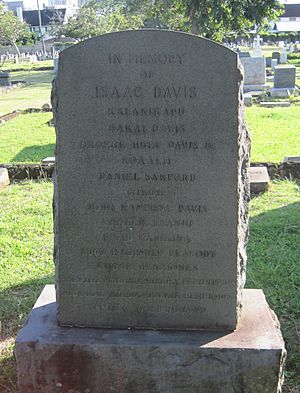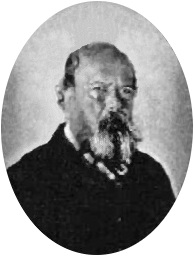Isaac Davis (advisor) facts for kids
Quick facts for kids Isaac Davis |
|
|---|---|
| High Chief ʻAikake | |
| Born | c.1758 Milford Haven, Wales, Kingdom of Great Britain |
| Died | April 1810 Honolulu, Oahu, Kingdom of Hawaii |
| Spouse | Nakai Nalimaʻaluʻalu Kalukuna |
| Issue | Sarah Kaniʻaulono Elizabeth Peke George Hueu |
Isaac Davis (born around 1758, died 1810) was an important British advisor to Kamehameha I. He was one of the first Europeans to help Kamehameha unite the Hawaiian Islands.
Isaac Davis arrived in Hawaii in 1790. He was the only survivor of an attack on his ship, the Fair American. Along with his friend John Young, Davis became a trusted advisor to Kamehameha. He shared his knowledge of Western military tactics. This helped Kamehameha greatly. Davis lived the rest of his life in Hawaii. He was known by his Hawaiian name, ʻAikake.
Contents
Isaac Davis's Early Life and Arrival in Hawaii
Isaac Davis was born in 1758 in Milford Haven, Wales. He worked as a sailor on a ship called the Fair American. This ship was involved in trading animal furs between the Pacific Northwest and China.
The Olowalu Incident
In 1790, another ship, the Eleanora, was sailing near Maui. Its captain, Simon Metcalfe, had a small boat stolen by a local chief. In response, Captain Metcalfe invited Hawaiian traders to his ship. But when their canoes approached, he fired cannons at them. This terrible event killed more than 100 unarmed Hawaiians.
The Attack on the Fair American
Captain Metcalfe had also treated a high chief named Kameʻeiamoku very badly. Kameʻeiamoku swore to get revenge on the next ship that arrived. He attacked the Fair American at [[Kaʻūpūlehu]]. This ship was commanded by Metcalfe's 18-year-old son, Thomas.
Thomas and almost all of his crew were killed in the attack. Isaac Davis was the only survivor. He was tied to a canoe and left for dead. Some stories say he was spared because he fought so bravely.
Becoming an Advisor to Kamehameha
In March 1790, Captain Simon Metcalfe left Hawaii without knowing his son had been killed. Kamehameha took control of the Fair American. Isaac Davis was nursed back to health by another American.
Like his friend John Young, Davis helped Kamehameha. He advised the king on how to deal with foreigners. He also helped Kamehameha in his wars to unite the islands.
Davis became known as ʻAikake. This was the Hawaiian way of saying his name, Isaac. He was given the important status of a high chief. He also married a relative of King Kamehameha I. Davis was made Governor of Oʻahu. He owned lands on Oʻahu, Maui, Molokaʻi, and the Big Island.
Isaac Davis's Family Life
Isaac Davis married a chiefess named Nakai Nalimaʻaluʻalu. They had one daughter in 1797, named Sarah Kaniʻaulono Davis. She was named after Isaac's sister in Wales. Sarah lived in Honokaula, Maui, and had six children. She passed away in 1867.
After Nakai passed away, Davis married Kalukuna. She was a relative of King Kamehameha. They lived in Honolulu and had two children. Their son, George Hueu Davis, was born in 1800. Their daughter, Elizabeth "Betty" Peke Davis, was born in 1803.
George Hueu Davis had many descendants. One of them was Isaac Young Davis. He was the second husband of Princess Ruth Keʻelikōlani. Another descendant was Lucy Kaopaulu Peabody. She served as a companion to Queen Emma of Hawaii. Betty Davis married George Prince Kaumualiʻi. He was the son of King Kaumualiʻi of Kauaʻi.
After Isaac Davis died, his friend John Young looked after his children. Young even divided his own lands equally between his children and Davis's children in his will.
Isaac Davis's Death

King Kaumualiʻi of Kauaʻi agreed to join Kamehameha's kingdom. He would rule Kauaʻi as a vassal, meaning he would be loyal to Kamehameha. However, some other chiefs were angry about this agreement. They planned to kill King Kaumualiʻi while he was on Oahu.
Isaac Davis found out about this secret plot. He quickly warned King Kaumualiʻi. Kaumualiʻi left immediately and sailed back to Kauaʻi. The poison that was meant for Kaumualiʻi was instead given to Isaac Davis.
Isaac Davis suddenly died in April 1810. He was 52 years old. He was buried in Honolulu. His tombstone reads:
The remains of
Isaac Davis
who died on this Island
April, 1810
Aged 52 years
This cemetery is located near the Hawaii State Library in Honolulu.
Isaac Davis had been one of Kamehameha's closest friends and advisors. His death was a great shock to the king. It cast a sad shadow over the peaceful agreement with Kauaʻi.


